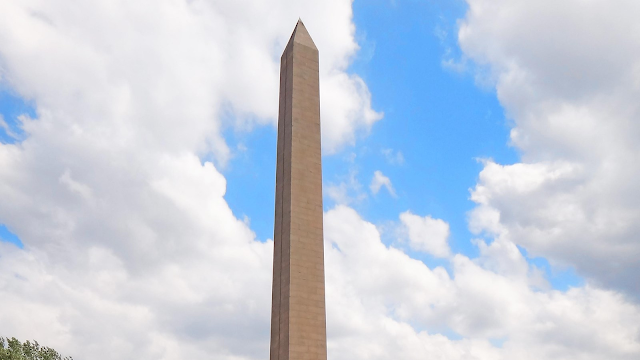This is an article from The Sioux City Journal. The Floyd Memorial is just one of the historical monuments in the area.
Sgt. Charles Floyd got very sick in the summer of 1804.
On July 31, 1804, Floyd wrote in his diary: "I am verry sick and has ben for Sometime but have Recovered my helth again."
Floyd's improved "helth" would not last, however; he had only three weeks to live.
The explorer, a member of the Lewis & Clark Expedition, was stricken with what was described as "bilious colic." His condition was consistent with what is now known as appendicitis. There was no doctor available in this uncharted spot, at the time part of the newly acquired Louisiana Purchase.
He was probably just as well off without a doctor. Medicine in that era was primitive and unscientific at best, and often cruel and counterproductive.
Floyd died Aug. 20, 1804, in the area that is now Sioux City. He was the sole member of the Corps of Discovery to die during the hazardous journey. William Clark wrote in his diary that "We buried him on the top of the bluff 1/2 Mile below a Small river to which we Gave his name, he was buried with the Honors of War, much lamented," according to the Sioux City Public Museum.
Fellow Corps of Discovery explorer Patrick Gass described Floyd's burial as being conducted "in the most decent manner our circumstances would admit."
A cedar post was used as a grave marker, inscribed: "Sergt. C. Floyd died here 20th of August 1804."
Fifty years after Floyd died, a city sprang up in the area near his grave. By 1857, according to the museum, the grave itself had fallen into disrepair; Sioux Cityans gathered what remained of his remains and re-buried them in a walnut coffin.
By the 1890s, a decades-long, nationwide historical monuments craze was intensifying. In the eastern states, scores of monuments were built to commemorate the Civil War.
In 1894, Floyd's journals from the expedition were rediscovered, according to the Sioux City Public Museum. In an era when community leaders everywhere itched for something important to immortalize in stone and bronze, the memory of Charles Floyd sprang back to life.
Unfortunately, in the decades since his 1857 reburial, cattle had trampled the grave and (as was common practice in those days) souvenir seekers took whatever they could get from the gravesite. Eventually nothing was left above ground; no one knew where exactly the grave was.
On Memorial Day, 1895, after a lot of searching, Floyd's grave was rediscovered. His remains were placed in two earthenware urns and reburied again on Aug. 20, 1895, according to the museum. A special re-interment service was held, and a more-permanent grave marker was installed -- a four-foot-by-eight-foot marble slab over the grave.
That same year, the Floyd Memorial Association was formed to see that Sgt. Floyd would get an even more substantial grave marker.
A decade earlier, the Washington Monument -- which had been under construction in fits and starts since 1848 -- was at last completed and dedicated. An enormous Egyptian-style obelisk was used to honor the first president; obelisks, and Egyptian-inspired decorative arts in general, were very popular at the time.
Sgt. Charles Floyd would also be honored with an obelisk. Floyd's obelisk, however, would be less than one-fifth the height of the 555-foot Washington Monument.
Help poured in from all around: $13,400 was secured from the federal government, the state of Iowa, Woodbury County and from private sources of funding. Colonel Chittenden with the United States Engineer's Office in Sioux City offered his services, according to the museum. Materials for the monument were transported free of charge by the railroads.
The foundation of the monument was laid May 29, 1900. On Aug. 20, the cornerstone was ceremoniously laid, 96 years to the day after Floyd died. The obelisk's capstone was placed on April 22, 1901, and the finished monument was dedicated on Memorial Day, 1901. Thousands of people attended the ceremonies.
Sgt. Floyd's remains are entombed inside the Floyd Monument, in its concrete core. The exterior of the monument is built of Kettle River sandstone; like the Washington Monument, its pointed cap is made of aluminum, a relatively innovative element at the time.
(The aluminum tip, depending on the ambient light, doesn't always have the shiny, bright appearance of other aluminum objects; often it has a rather darkened appearance. This likely contributed to the "big pencil" moniker the monument eventually garnered, as the darkened aluminum point does bear some resemblance to the graphite point of a wooden pencil.)
In 1960, the Floyd Monument would become the first-ever National Historic Landmark in the U.S.
Though the monument outwardly looks like the sort of thing that lasts forever with little or no maintenance, it is in fact showing its age. For more than a year, the Sioux City Parks and Recreation Department has been keeping an eye on the monument's condition; spalling, a phenomenon wherein pieces or flakes of material break away from a larger body, has been noted on the south part of the landmark.
The obelisk last underwent repairs in 1998.
Visitors can see the monument at 2601 S. Lewis Blvd. Also, details about the Lewis and Clark expedition can be found at the Lewis and Clark Interpretive Center, 900 Larsen Park Road, at the Sergeant Floyd River Museum, also at Larsen Park Road.
